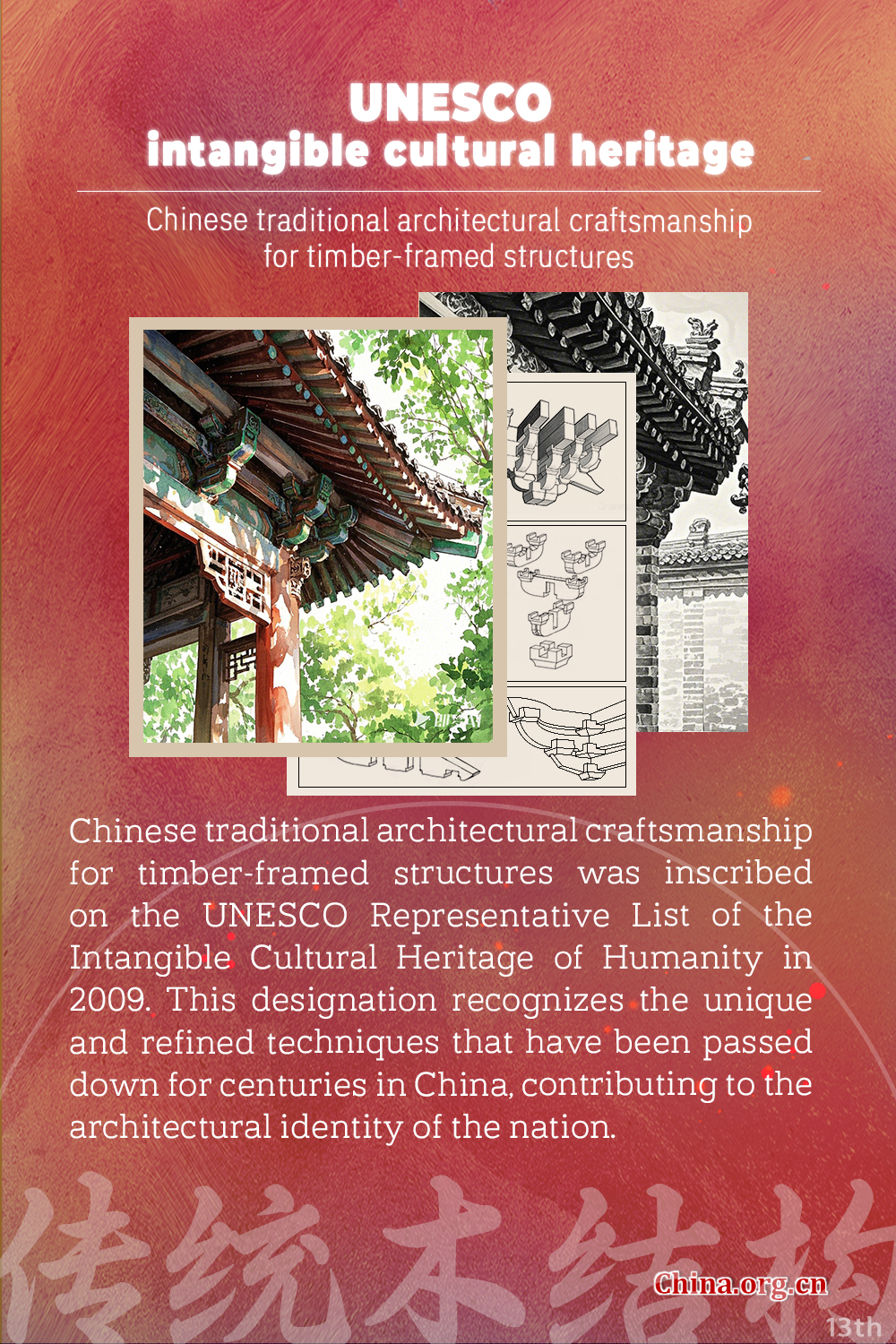
 0 Comment(s)
0 Comment(s) Print
Print E-mail China.cn, April 16, 2025
E-mail China.cn, April 16, 2025Editor's note: Chinese traditional architectural craftsmanship for timber-framed structures was inscribed on the UNESCO Representative List of the Intangible Cultural Heritage of Humanity in 2009. This designation recognizes the unique and refined techniques that have been passed down for centuries in China, contributing to the architectural identity of the nation.

Timber-framed structures in traditional Chinese architecture are a marvel of craftsmanship, characterized by intricate joinery, sustainable design and aesthetic harmony. These buildings, often temples, palaces and residential houses, reflect not only architectural prowess but also the deep cultural and philosophical understanding of balance, nature and durability.
The origins of Chinese timber-framed architecture date back thousands of years, with the earliest examples appearing during the Shang dynasty (16th–11th century BC). During the Han dynasty (206 BC–220 AD), the framework of timber construction was further refined.
In ancient China, timber was the preferred material for constructing large-scale buildings, largely due to its abundant availability and versatility. The traditional technique involves a complex system of wooden beams, columns and brackets that support the structure without the need for nails or other metal fasteners. This craftsmanship is deeply tied to Confucian, Taoist and Buddhist philosophies, where the structure must align with nature and maintain harmony with its environment.
Over centuries, timber framing evolved into a refined art form, with regional variations and specialized techniques emerging in different parts of China. The Song dynasty (960–1279) saw further advancements in engineering and aesthetics, and the Ming (1368–1644) and Qing (1644–1911) dynasties marked the golden age of Chinese timber-framed buildings, as these techniques reached their peak in terms of scale, complexity and decorative artistry.
One of the most remarkable achievements of this tradition is the "dougong" bracket system, a sophisticated method of interlocking wooden components that helps distribute weight, providing both strength and flexibility. This system, together with the intricate joinery techniques, enabled the construction of vast wooden buildings that could withstand earthquakes, heavy winds and the test of time.
Today, the legacy of Chinese traditional timber-framed architecture remains integral to the cultural heritage of China. Although modern construction materials such as steel and concrete have largely replaced wood in the creation of contemporary buildings, the traditional timber-framed techniques continue to influence architectural practices, particularly in the preservation and restoration of historical buildings. There are still skilled artisans and carpenters who continue to preserve these techniques, albeit in a more specialized and limited context. In rural regions and in certain temples or heritage sites, timber-framed structures continue to stand as symbols of traditional craftsmanship.
However, the number of these buildings is dwindling due to urbanization and the pressures of modernization. Many traditional wooden structures are at risk of decay and destruction, which has led to increased efforts to protect and revitalize this invaluable heritage. The Chinese government, along with various cultural organizations, is actively involved in promoting the preservation of these architectural treasures through restoration projects, education and fostering public awareness of the significance of this craft.
UNESCO's recognition of Chinese traditional architectural craftsmanship for timber-framed structures highlights the immense cultural significance of this practice, not only for China but for humanity as a whole. UNESCO notes that the craftsmanship embodies an ancient and sustainable architectural system that integrates knowledge of materials, design and structural engineering. The "dougong" system, in particular, is seen as a symbol of the ingenuity and wisdom of Chinese builders.
UNESCO's designation underscores the importance of preserving this art form for future generations. In its assessment, the organization emphasizes the need for continued efforts in education, transmission of skills and the protection of existing structures. The recognition also fosters international awareness and appreciation of this unique aspect of Chinese cultural heritage, ensuring that the techniques will not be forgotten in the face of modern construction trends.
Overall, the inclusion of Chinese traditional timber-framed architectural craftsmanship on the UNESCO list serves as a celebration of the harmony between craftsmanship, nature and culture, and it marks a crucial step in preserving a legacy that has shaped not only China's architectural landscape but also the cultural identity of the Chinese people.
Discover more treasures from China on UNESCO's ICH list:
? 2024: Spring Festival
? 2022: Traditional tea processing
? 2020: Wangchuan ceremony, taijiquan
? 2018: Lum medicinal bathing of Sowa Rigpa
? 2016: Twenty-four solar terms
? 2013: Abacus-based Zhusuan
? 2012: Training plan for Fujian puppetry performers
? 2011: Shadow puppetry, Yimakan storytelling
? 2010: Peking opera, acupuncture and moxibustion, wooden movable-type printing, watertight-bulkhead technology of Chinese junks, Meshrep
? 2009: Yueju opera, Xi'an wind and percussion ensemble, traditional handicrafts of making Xuan paper, traditional firing techniques of Longquan celadon, Tibetan opera, sericulture and silk craftsmanship, Regong arts, Nanyin, Khoomei, Mazu belief and customs, Dragon Boat Festival, Manas, Craftsmanship of Nanjing Yunjin brocade, Xinjiang Uygur Muqam art, Hua'er, China engraved block printing technique
